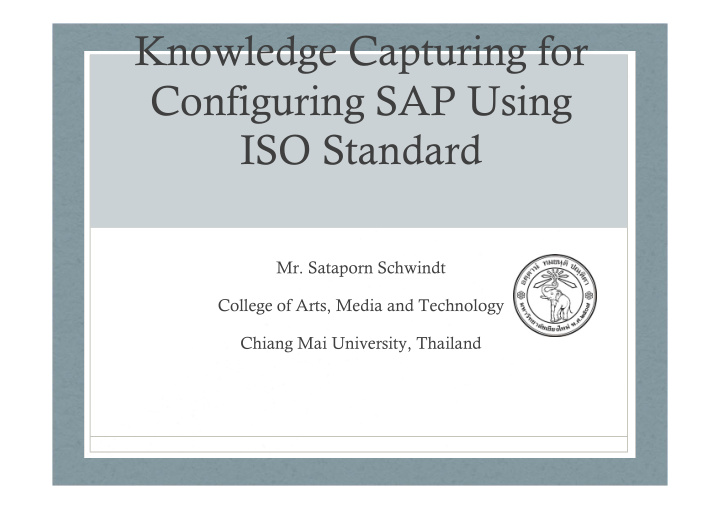



Knowledge Capturing for Configuring SAP Using ISO Standard Mr. Sataporn Schwindt College of Arts, Media and Technology Chiang Mai University, Thailand
Introduction • SAP: Systems, Applications and Products • The SAP ERP application is an integrated enterprise resource planning (ERP) software manufactured by SAP AG • It uses the concept of modules • The implementation of SAP software, such as SAP R/3 is almost always a massive operation that brings a lot of changes in the organization.
Problems • It may not fit a company's business model exactly. To implement the SAP software in an organization, configuration process is necessary. • Locked into relationship by contract and manageability with vendor/SAP consultant - a contract can hold a company to the vendor/SAP consultant until it expires. Cost of switching vendors/SAP consultant is very high
Purpose of the study • To capture the knowledge from the SAP consultant while configuring the system by using ISO/IEC 15504 standard. • *To assess the captured knowledge.
Background • ISO/IEC 15504, also known as SPICE (Software Process Improvement and Capability Determination) • It is a "framework for the assessment of processes" • It was developed by the Joint Technical Subcommittee between ISO (International Organization for Standardization) and IEC (International Electrotechnical Commission)
• Initially, it was derived from process lifecycle standard ISO 12207 and from maturity models like Bootstrap, Trillium and the CMM. • ISO/IEC 15504 contains a reference model defines a process dimension and a capability dimension.
Process categories and process groups
Relationship between the Process Assessment Model and its inputs
Methodology The process dimension of the Process Assessment Model • provides information in the form of a) a set of base practices for the process providing a definition of the tasks and activities needed to accomplish the process purpose and fulfil the process outcomes b) a number of input and output work products associated with each process and related to one or more of its outcomes; and c) characteristics associated with each work product.
RIN.3 Process ID Knowledge management Process Name The purpose of the Knowledge management process is Process Purpose to ensure that individual knowledge, information and skills are collected, shared, reused and improved throughout the organization. As a result of successful implementation of Knowledge Process Outcomes management process: 1) infrastructure is established and maintained for sharing common and domain information across the organization; 2) knowledge is readily available and shared throughout the organization; and 3) the organization will select an appropriate knowledge management strategy. RIN.3.BP1: Establish a knowledge management system. Base Practices Establish and maintain a knowledge management infrastructure and mechanism to support the activities to identify, classify, exchange and use knowledge assets. [Outcome: 1, 2] RIN.3.BP2: Create the network of knowledge contributors. Establish the network of experts and their mutual interaction [Outcome: 2 3]
Work Products Inputs Outputs 01-04 Knowledge item [Outcome: 2] 03-02 Asset use data [Outcome: 2] 05-02 Business goals [Outcome: 3] 13-04 Communication record [Outcome: 2] 13-04 Communication record [Outcome: 2] 16-04 Knowledge repository [Outcome: 1, 2] 16-04 Knowledge repository [Outcome: 1] 19-03 Knowledge management strategy [Outcome: 3]
Scope of the study • Some SAP module will be selected • ISO/IEC 15504 processes that will be used • RIN.3 Knowledge Management • REU.2 Reuse Program Management • REU.3 Domain Engineering • Case study: Master degree student theses using SAP
Recommend
More recommend